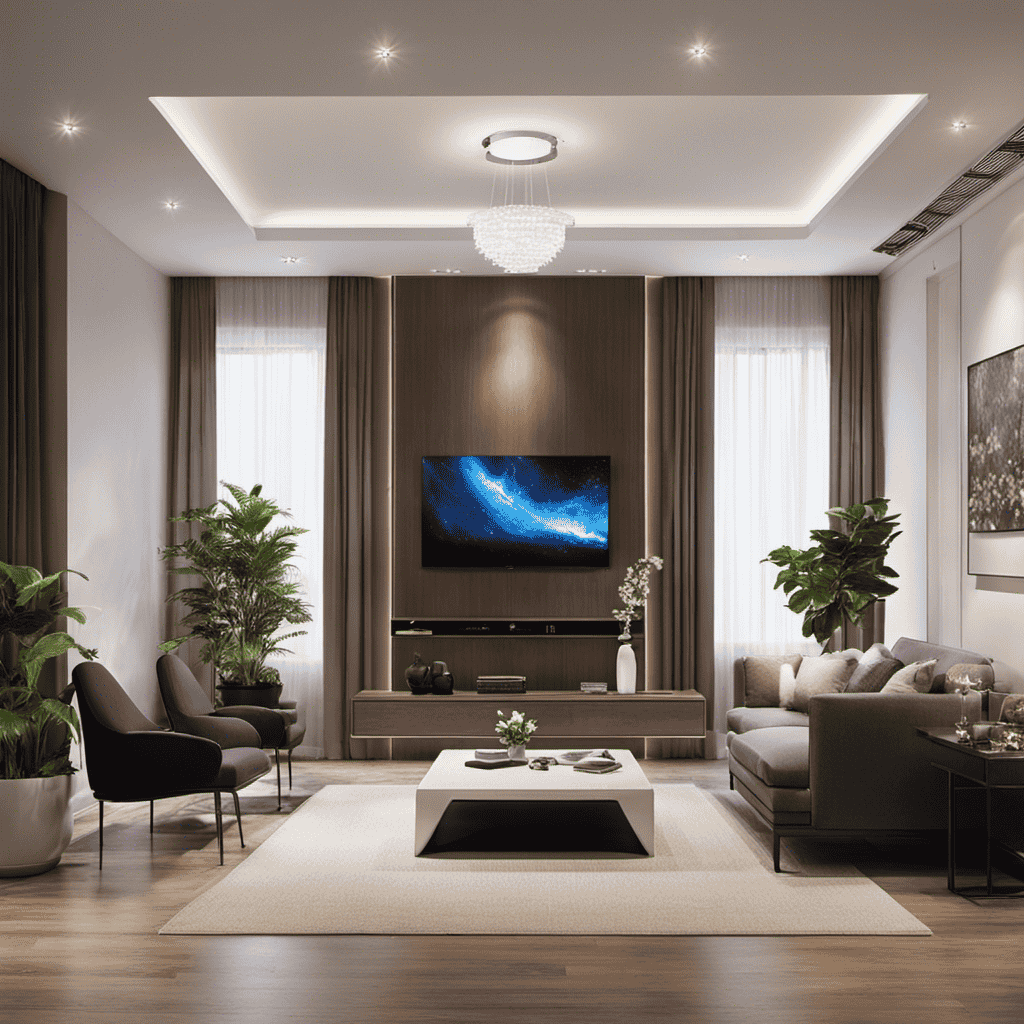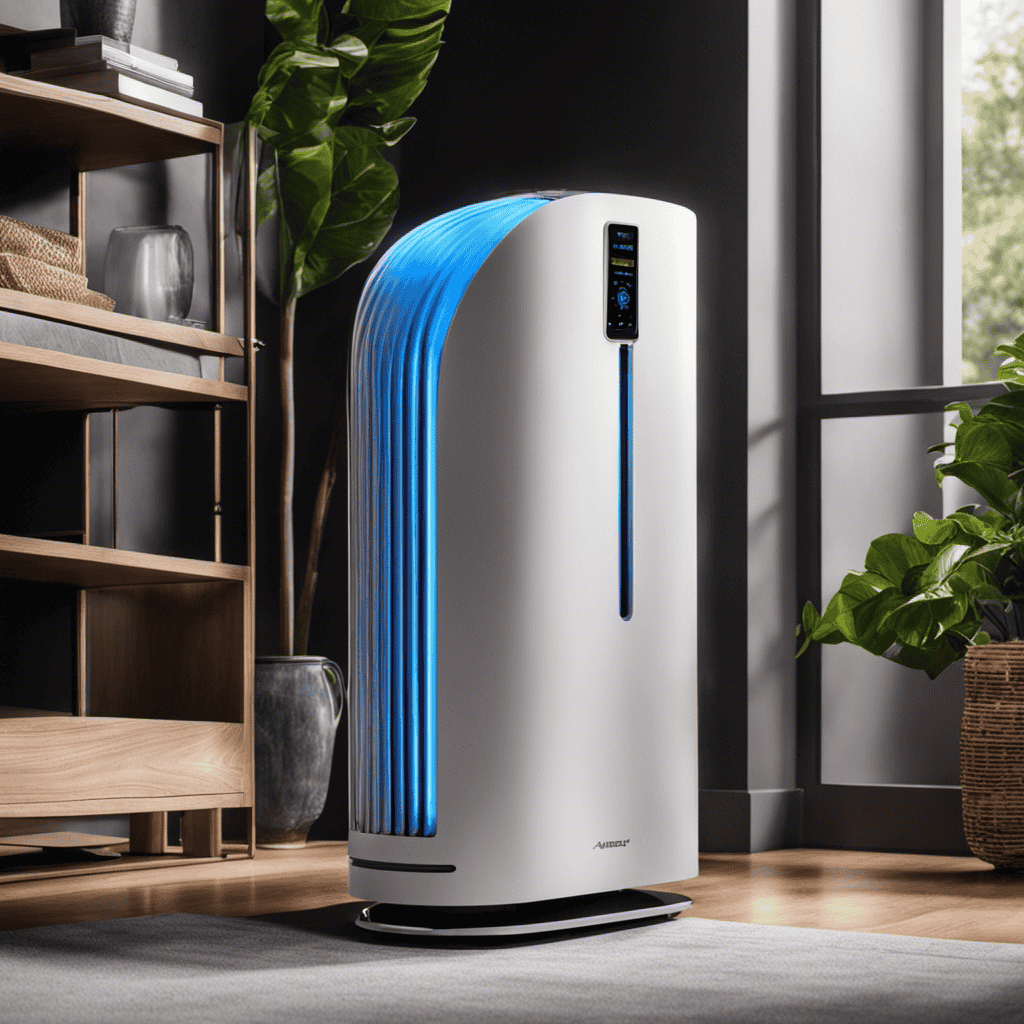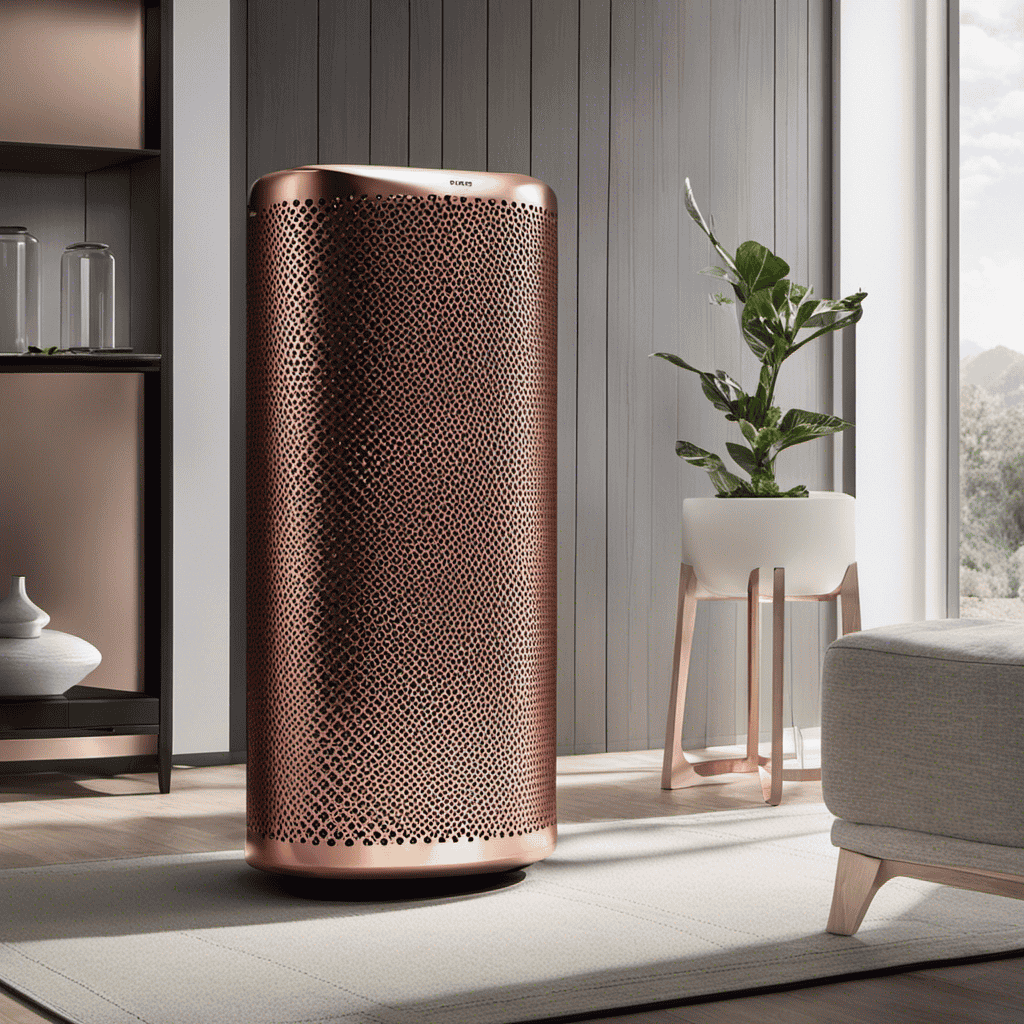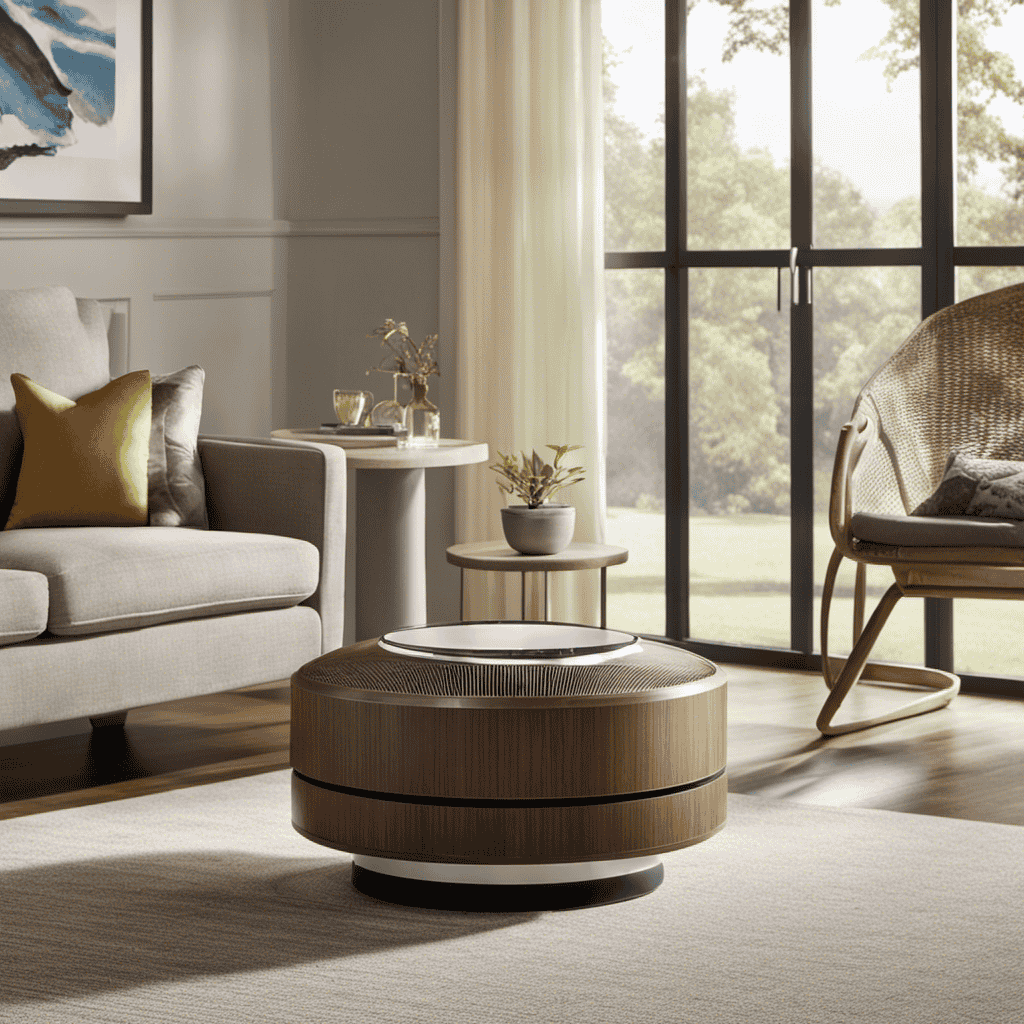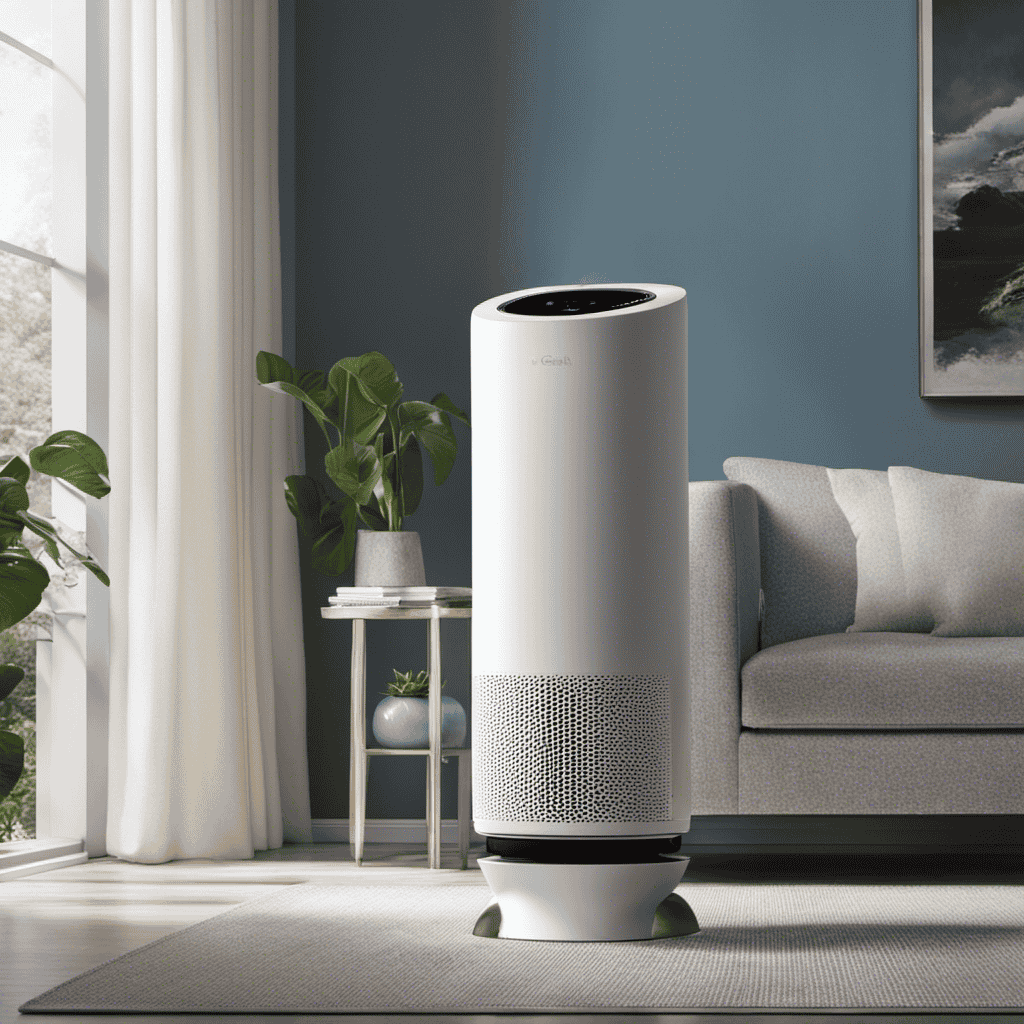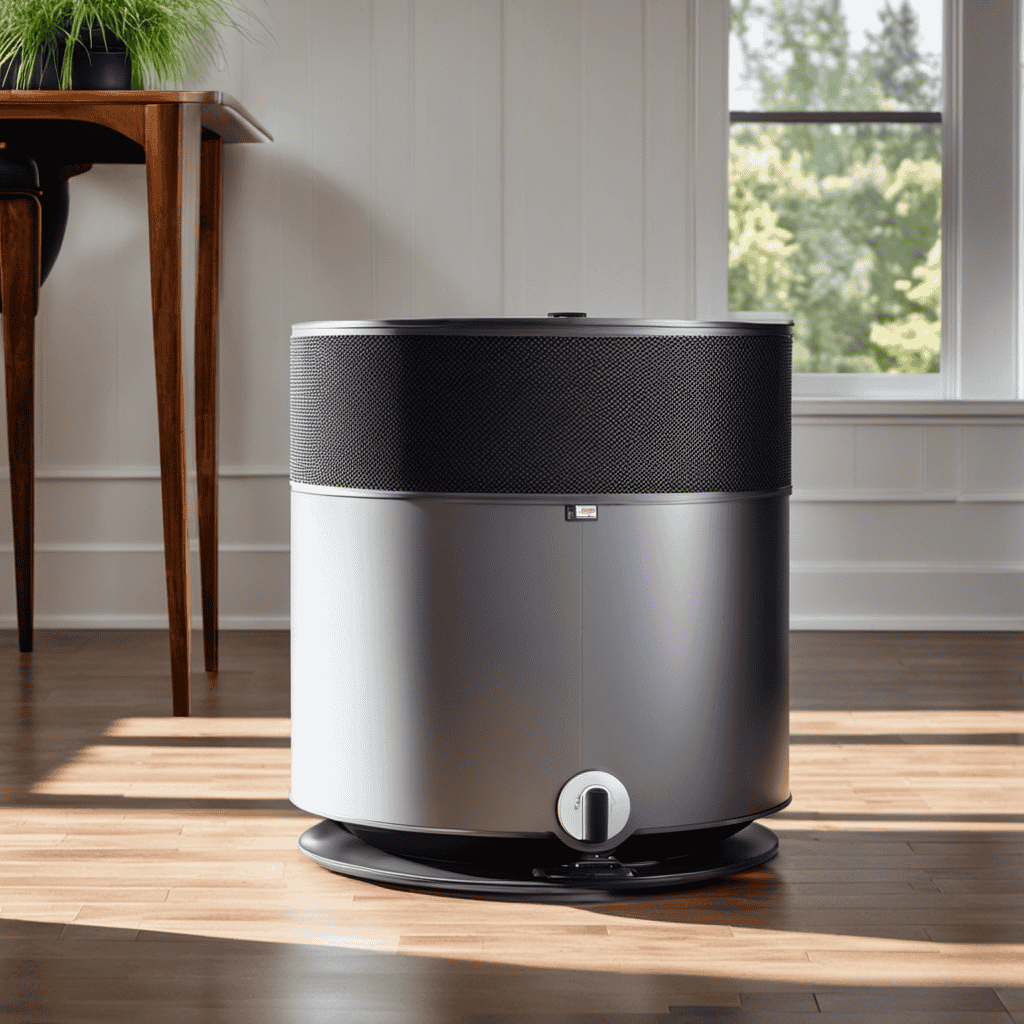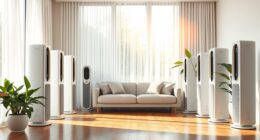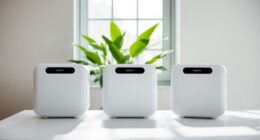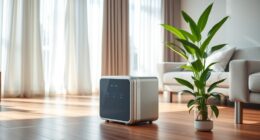When choosing an air purifier, it may seem overwhelming with all the different options available. However, do not worry! I am here to help clarify things.
Picture this: you walk into a room, the air is crisp and pure, free from allergens and pollutants. Ah, what a breath of fresh air!
In this article, I’ll guide you through the process of determining the perfect size air purifier for your needs, taking into account factors like room size, pollutant levels, and filter types.
Let’s dive in, shall we?
Key Takeaways
- Understanding the Clean Air Delivery Rate (CADR) and Air Changes per Hour (ACH) is crucial for evaluating air purifier performance.
- Assessing room size and air quality helps determine the appropriate air purifier capacity.
- Determining the Air Changes per Hour (ACH) requirement is essential for selecting the right air purifier.
- Considering the types and levels of pollutants in your home, as well as the cost effectiveness and energy consumption of the air purifier, is important in selecting an appropriate size.
Understanding Air Purifier Coverage Area
When determining the size of an air purifier you need, it’s important to understand the coverage area. Evaluating air purifier effectiveness is crucial in ensuring that the device is capable of efficiently cleaning the air in your room. This effectiveness is directly linked to the size of the purifier and its ability to handle the room’s dimensions.
To evaluate the coverage area of an air purifier, you should consider the Clean Air Delivery Rate (CADR) and the Air Changes per Hour (ACH). CADR measures the purifier’s ability to remove pollutants, while ACH indicates how many times the air in the room can be cleaned within an hour.
Understanding air purifier maintenance is also essential as it affects the unit’s performance. Regularly cleaning or replacing filters is necessary to maintain optimal functionality.
Evaluating Room Size and Air Purifier Capacity
To accurately determine the appropriate air purifier for your room, you’ll need to assess the dimensions and consider the capacity needed. Evaluating the air quality in your room is crucial in understanding the benefits of air purifiers. By examining the size of your room, you can determine the appropriate air purifier capacity required to effectively clean the air.
To help you make an informed decision, here is a table that showcases the recommended air purifier capacity based on room size:
| Room Size | Air Purifier Capacity |
|---|---|
| Small (up to 150 sq. ft) | CADR of 100-150 |
| Medium (151-300 sq. ft) | CADR of 200-300 |
| Large (301-500 sq. ft) | CADR of 300-400 |
| Extra Large (501+ sq. ft) | CADR of 400+ |
Evaluating the air quality of your room and selecting an air purifier with the appropriate capacity will ensure that you can benefit from cleaner and healthier air.
Determining the Air Changes per Hour (ACH) Requirement
Assessing the air changes per hour (ACH) requirement is essential for ensuring that you have the right air purifier for your room. Evaluating performance and calculating effectiveness are key factors in determining the ACH requirement.
Here are some important points to consider:
-
Room size: Measure the square footage of your room to determine the appropriate ACH requirement.
-
Pollutant types: Consider the types of pollutants present in your home, such as dust, pollen, pet dander, or smoke.
-
Pollutant levels: Assess the levels of pollutants in your home, whether they are low, moderate, or high.
Considering the Pollutant Types and Levels in Your Home
Considering the types and levels of pollutants in my home is crucial for selecting the right air purifier. Evaluating cost effectiveness and considering energy consumption are also important factors to keep in mind.
When it comes to pollutants, it’s essential to identify the specific types that are present in my home. This can include dust, pollen, pet dander, mold spores, and even volatile organic compounds (VOCs) from cleaning products or furniture. By understanding the specific pollutants, I can choose an air purifier that is designed to effectively remove them from the air.
Additionally, I need to consider the levels of pollutants in my home. If I live in an area with high pollution levels or have specific indoor sources, I may need a more powerful air purifier.
Evaluating the cost effectiveness of an air purifier is crucial as well. This involves considering the initial cost of the unit, as well as any ongoing maintenance or filter replacement costs. It’s important to find a balance between affordability and effectiveness.
Lastly, considering energy consumption is important for both environmental and financial reasons. Energy-efficient air purifiers can help reduce electricity bills and minimize environmental impact.
Assessing the Air Purifier’s CADR (Clean Air Delivery Rate
When it comes to assessing the CADR (Clean Air Delivery Rate) of an air purifier, there are a few key points to consider.
Firstly, it’s important to understand that different rooms may require different CADR levels in order to effectively purify the air. This is because the size of the room and the level of pollutants present can vary significantly.
Secondly, choosing the right size of air purifier is crucial to ensure optimal performance. A unit that is too small may not be able to effectively clean the air, while a unit that is too large may consume unnecessary energy.
Lastly, the importance of effective filtration cannot be stressed enough. A high CADR rating is useless if the air purifier doesn’t have a quality filtration system that can trap and remove a wide range of contaminants.
CADR for Different Rooms
The CADR ratings will help you determine the size of air purifier you need for different rooms. It’s important to evaluate the effectiveness of an air purifier before making a purchase. Here are a few key points to consider when selecting the optimal air purifier for your home:
-
CADR ratings: Look for air purifiers with high CADR ratings as they indicate better air cleaning performance. The higher the rating, the faster the purifier will clean the air in a given room.
-
Room size: Consider the square footage of the room you intend to place the air purifier in. Different air purifiers are designed to cater to different room sizes, so make sure to choose one that is suitable for your specific needs.
-
Pollutant types: Identify the specific pollutants you want to remove from the air, such as dust, pollen, pet dander, or smoke. Some air purifiers are more effective at targeting certain pollutants than others.
Choosing the Right Size
To choose the right air purifier, you’ll need to assess the square footage of the room where it will be placed. Evaluating the performance of different air purifiers is crucial to ensure that you’re getting the most effective one for your needs.
When comparing features, consider the CADR (Clean Air Delivery Rate) as it indicates how efficiently the purifier can remove pollutants from the air. Look for a purifier that has a CADR rating suitable for the square footage of your room.
Additionally, pay attention to the filtration system, noise level, and maintenance requirements. Some purifiers offer additional features like smart controls or air quality sensors, which can enhance the overall experience.
Importance of Effective Filtration
Evaluate the effectiveness of filtration systems to ensure that you’re breathing in clean and purified air. Understanding the importance of effective filtration is crucial for maintaining good indoor air quality. Here are three reasons why evaluating filtration effectiveness is essential:
-
Improved respiratory health: A high-quality filtration system can remove airborne particles, such as dust, pollen, and pet dander, reducing the risk of respiratory issues and allergies.
-
Reduced exposure to pollutants: Filtration systems can capture harmful pollutants like volatile organic compounds (VOCs) and mold spores, improving the overall air quality and creating a healthier living environment.
-
Enhanced overall well-being: Breathing in clean air can boost your immune system, improve sleep quality, and increase productivity, leading to a better quality of life.
Choosing the Right Filter Type for Your Needs
When it comes to choosing an air purifier, it’s important to consider your specific air quality requirements and the size of the room where it will be used.
Understanding the air quality requirements will help you determine the type of filtration system you need to effectively remove pollutants and allergens from the air.
Additionally, considering the room size is crucial in ensuring that the air purifier has the capacity to adequately clean the air in that space.
Air Quality Requirements
You’ll want to consider your specific air quality requirements before deciding on the size of the air purifier to purchase. Evaluating the air quality in your space is crucial in selecting the appropriate purifier.
Here are a few factors to consider:
-
Room size: Measure the square footage of the room where you plan to use the air purifier. This will help determine the appropriate coverage area.
-
Allergens and pollutants: Identify the specific allergens or pollutants you want to target. Different purifiers are designed to capture different particles, such as dust, pet dander, pollen, or smoke.
-
Sensitivities and health conditions: If you have specific sensitivities or health conditions like asthma, it’s important to choose a purifier that can effectively remove the particulates that trigger your symptoms.
Room Size Considerations
Now that we understand the air quality requirements for our homes, let’s discuss the importance of considering room size when choosing an air purifier. Evaluating the cost effectiveness and energy efficiency of an air purifier is crucial to ensure maximum performance and savings.
To help you visualize the relationship between room size and air purifier size, I’ve created a table below:
| Room Size | Recommended Air Purifier Size |
|---|---|
| Small (up to 150 sq ft) | Compact (up to 300 sq ft) |
| Medium (150-300 sq ft) | Medium (300-600 sq ft) |
| Large (300-700 sq ft) | Large (600-1,400 sq ft) |
| Extra Large (700+ sq ft) | Extra Large (1,400+ sq ft) |
By matching the air purifier size to your room size, you can ensure optimal air purification without wasting energy or overspending.
Now that we understand the importance of room size, let’s dive into comparing different air purifier models and sizes.
Comparing Different Air Purifier Models and Sizes
If you’re comparing different air purifier models and sizes, it’s important to consider the square footage of the room you want to purify. Evaluating cost options and comparing energy efficiency are also crucial factors when making a decision.
Here are some key points to keep in mind:
-
Room size: Determine the square footage of the room where you plan to use the air purifier. This will help you choose the appropriate size and capacity for optimal purification.
-
Cost options: Look for air purifiers that offer a good balance between price and performance. Consider the initial cost, as well as ongoing maintenance expenses such as filter replacements.
-
Energy efficiency: Check the energy efficiency rating of the air purifier. Look for models that are ENERGY STAR certified, as they are designed to consume less energy and save you money on electricity bills.
Factoring in Noise Levels and Placement Options
Consider the noise levels and placement options when choosing an air purifier for your space. Noise levels can vary greatly between different models, so it’s important to take this into account, especially if you plan on using the air purifier in a bedroom or office where quiet is essential.
Look for air purifiers that have a low decibel rating, typically below 50 dB, to ensure a peaceful environment.
Placement options are also crucial in maximizing the effectiveness of your air purifier. Ideally, it should be placed in a central location, away from walls and furniture, to allow for proper air circulation. Avoid placing it near sources of dust or pollutants, such as windows or doors.
Now that you understand the importance of noise levels and placement options, it’s time to consult with experts or seek professional recommendations for further guidance.
Consulting With Experts or Seeking Professional Recommendations
Consulting with professionals or seeking recommendations from experts can be beneficial when choosing the right air purifier for your space. Here are some reasons why:
-
Expertise: Professionals have extensive knowledge and experience in the industry. They can provide valuable insights and tailored advice based on your specific needs.
-
Product Knowledge: Experts are well-versed in the different types of air purifiers available, their features, and their effectiveness. They can recommend the most suitable options for you.
-
Cost-Effectiveness: By consulting experts, you can avoid purchasing an air purifier that may not be suitable for your space. This can save you money in the long run.
Frequently Asked Questions
How Do I Know if My Home Has High Pollutant Levels?
I can determine high pollutant levels in my home by using an air quality monitor. High levels can cause health issues like allergies and respiratory problems. It’s important to address these issues with an appropriate air purifier.
Can I Use an Air Purifier in a Small Bedroom?
Sure, I can use an air purifier in a small bedroom. It’s a great way to improve indoor air quality and reduce allergens. Just make sure to choose an air purifier that is appropriate for the room size.
Are There Air Purifiers Specifically Designed for Pet Dander?
Yes, there are pet-friendly air purifiers that specifically target pet dander. These purifiers can help eliminate allergens and odors caused by pets, making them beneficial for pet owners looking to improve air quality in their homes.
What Is the Recommended Placement for an Air Purifier?
Recommended placement for an air purifier depends on the specific needs and goals. However, placing one in the bedroom can provide numerous benefits, such as improved air quality, reduced allergens, and better sleep.
How Do I Determine the Noise Level of an Air Purifier Before Purchasing It?
Determining noise levels of an air purifier before purchasing it involves researching product specifications and reading customer reviews. To maintain air purifier efficiency, regularly clean the filters and follow manufacturer’s instructions for maintenance.
What Size Air Purifier Do I Need for My Room If I Have Pets?
When considering the size coverage for pet purifier, it’s important to factor in the square footage of the room and the number of pets. For a smaller room with one pet, a purifier with a coverage area of 200-300 square feet might suffice. Larger rooms or multiple pets may require a purifier with greater coverage.
Conclusion
In conclusion, when it comes to buying an air purifier, it is crucial to consider the size of the purifier based on the coverage area of your room.
While it may be tempting to purchase a smaller purifier to save money, it is important to remember that a purifier that is too small will not effectively clean the air in your space.
One potential objection may be the cost of purchasing a larger purifier, but it is worth investing in a size that meets your room’s needs for optimal air purification.
By selecting the right size, you can ensure clean and fresh air for you and your loved ones.
